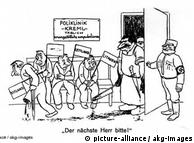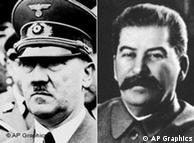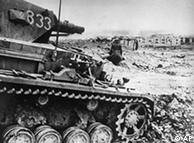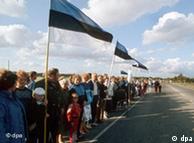WORLD WAR II | 23.08.2009
70 years ago, Soviet-Nazi pact called for division of Europe
It was 1939, and although Europe was still at peace, storm clouds were on the horizon.
German war planners had already estimated that without a steady supply of raw materials from the Soviet Union, Germany would be hard pressed to sustain any sort of protracted conflict.
The last thing Hitler needed was a war with the Soviets. After months of negotiations, his Foreign Minister Joachim von Ribbentrop flew to Moscow and met with his counterpart Vyacheslav Molotov. On Aug. 23, they signed an agreement, most commonly known as the Molotov-Ribbentrop Pact.
The negotiations took place in secret, at the same time as France and Britain negotiated an alliance with Stalin.
Though primarily a non-aggression pact, the document incorporated some economic components.
Provisions under the agreement included: arbitration in the event of a disagreement, consultation and neutrality if either Russia or Germany went to war against a third power. The pact also stipulated that neither party could join a group or alliance "directly or indirectly aimed at the other."
Only after Germany's defeat in 1945 did details of the secret protocols of the pact emerge.
 As this 1939 cartoon shows, many saw Stalin as the butcher of the Baltic states
As this 1939 cartoon shows, many saw Stalin as the butcher of the Baltic states
Secret protocols envisaged carve-up of Europe
The protocols divided Europe into German and Soviet spheres of control. Latvia and Estonia were to be in the Soviet sphere. Lithuania, the part that was adjacent to East Prussia, was to come under German control. Later the protocol was altered, assigning Lithuania to the Soviets as well.
 Hitler and Stalin helped each other prepare for WWII
Hitler and Stalin helped each other prepare for WWII
To the north, Finland was to be carved off for Stalin. Poland was to be partitioned, and soon after the pact was signed, both powers invaded the country to take their respective pieces.
Immediately afterwards, Russia invaded Finland, but the Red Army were repelled in the famous "Winter War" of 1939/1940. After holding their ground for four months and inflicting terrible casualties on the Russians, the heavily outnumbered Finns were militarily exhausted, and they sued for peace.
Stalin annexed Finland's eastern province of Karelia, which led eventually to Finland and Germany signing an alliance. That alliance was to become a key element in Hitler's invasion of Russia.
Quarrelling between Germany and the Soviets escalated during the summer of 1940, as the Soviet Union refused to fulfill its economic commitments under the Molotov-Ribbentrop Pact, and both parties carried out military operations without informing the other.
The German war effort was heavily reliant on the Russian raw materials that the pact had aimed to secure, and Hitler's plans were increasingly frustrated. In August, Nazi Germany annexed part of Romania to gain access to oil fields.
Hitler tears up pact, invades
 Germany attacked the Soviet Union in 1941
Germany attacked the Soviet Union in 1941
On June 22, 1941, Hitler abrogated the Molotov-Ribbentrop Pact and launched Operation Barbarossa. The multifaceted invasion involved attacks along the entire eastern front, from Finland in the north to the Black Sea in the south.
The eventual failure of Barbarossa, the largest military operation in history, became the turning point in the Nazi's fortunes.
After Germany was defeated in 1945, Soviet troops remained in occupation across much of Eastern Europe, and the Baltic States. What the Allies didn't give Stalin as war reparations, he annexed anyway, until ending up with much of what the Soviets had claimed in the secret protocols of the Molotov-Ribbentrop Pact.
Details of the secret protocols dividing up Europe surfaced during the Nuremberg Trials in 1945-46 even though the Soviets continued to deny their existence. After the war, they justified their occupation of the Baltic States by claiming that the parliaments of Latvia, Lithuania and Estonia had petitioned to join the USSR.
The Baltic pro-independence movement
 Two million Balts protested against the Soviet Union in 1989
Two million Balts protested against the Soviet Union in 1989
In the early 1980s, as the Soviet Union embraced glasnost, the Baltic states' pro-independence protest movement gathered strength. On Aug. 23, 1986, large street protests were held across Latvia, Lithuania and Estonia to mark the anniversary of the Molotov-Ribbentrop pact.
In 1989, the fourth consecutive year of the protests, and the 50th anniversary of the pact, an especially large protest was planned, resulting in the so-called "Baltic Way". Two million Lithuanians, Latvians and Estonians linked arms to form a 671-kilometer (417-mile) long human chain, connecting the three capitals, Vilnius, Riga and Tallinn.
The Baltic pro-independence movements issued a joint declaration to the world and European community, condemning the Molotov–Ribbentrop Pact, and calling it a criminal act.
The declaration said independence for the Baltics was a question of "inalienable human rights," and accused the European community of ignoring the last colonies of the Hitler–Stalin era.
In December 1989, Soviet leader Mikhail Gorbachev and the Soviet Congress of People's Deputies signed a report condemning the Molotov-Ribbentrop pact.
On March 11, 1990, less than six months after the Baltic Way, Lithuania declared independence, the first Soviet State to do so. Within a year, all three Baltic states had declared independence and were internationally recognized as sovereign states.
ch/av/AFP/Reuters
Editor: Toma Tasovac


No comments:
Post a Comment